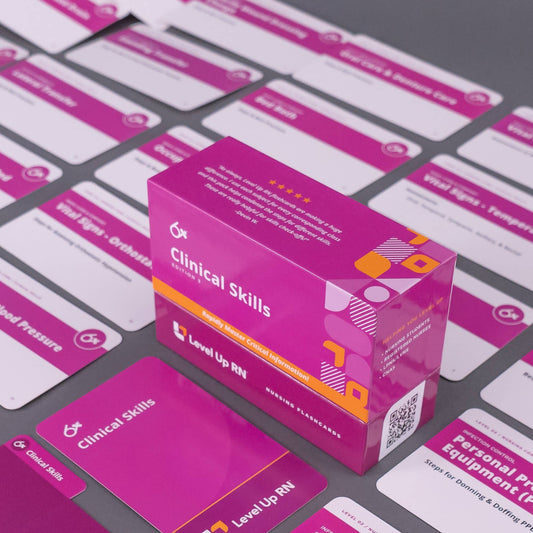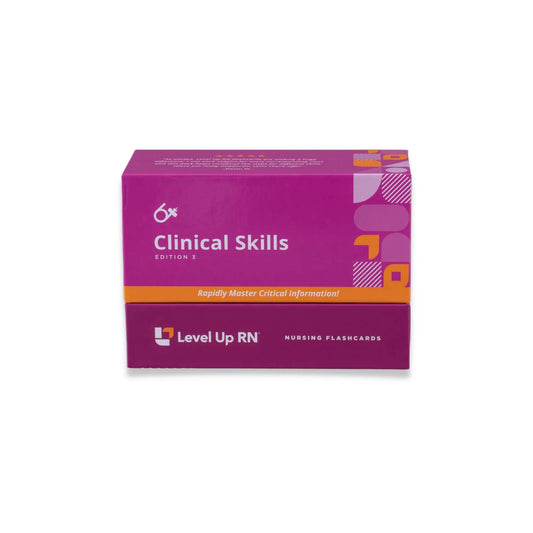Clinical Skills - Indwelling Urinary Catheter Insertion (Male)
Updated: Ellis ParkerHow to insert and remove an indwelling urinary catheter on a patient with a penis. After the demonstration, additional information on the balloon, its size, its purpose, and how to obtain a urine sample from a catheterized patient.
Full Transcript: Clinical Skills - Indwelling Urinary Catheter Insertion (Male)
Full Transcript: Clinical Skills - Indwelling Urinary Catheter Insertion (Male)
Hi, I'm Ellis with Level Up RN. In this video, I'll be demonstrating how to insert an indwelling urinary catheter on a patient that has a penis. I'll be following the steps from our Clinical Nursing Skills deck. So if you have this deck, grab these cards, and you can follow along, on the steps, with me. If you don't have the deck and you're interested in checking one out, head on over to leveluprn.com.
After the demonstration, we're going to come back here because I have a couple more tips and tricks I want to share with you about catheters. To insert an indwelling catheter on a patient who is male, we want to have already positioned them in a supine position and done any perineal care that's necessary. So I've already done that here. So I'm going to go ahead and open my kit. I'm going to take this bag and roll it down, a bit, in case I need a trash bag. I like to place it up here, going to go ahead and expose him while I'm setting up my sterile tray. I'm gonna unstick this. And then I like to do this at a bit of an angle. So I'll do my first. And then I do my sides and then, again, only pinching that outside material. I'll do the last one towards myself. I'm going to sneak in and grab this first drape. I'm going to only touch the outside, just pinching it gently, and put it on the bed, shining side down. I'm going to then go ahead and put on my sterile gloves. Most kits come with sterile gloves. But I just prefer to grab my size because I know my size, and this is more comfortable for me. So I'm going to do my sterile gloves, over here, on the edge of the table, so that I'm not, get back here, on top of my sterile field I've just created.
So I'm going to grab my first glove, putting it on my dominant hand, and go, and then, with my dominant hand, grabbing my second glove and pulling that onto my nondominant hand. All right. I'm going to just close that. All right. I can then grab my fenestrated drape, place that over this penis. And I can adjust this a bit after I finish setting up some of my tray. So I'm going to adjust this. These are the gloves that I'm not going to use. These are my simulated swab sticks, simply meaning, they don't have the Betadine or the coloring on them. And so they're safe for my mannequins. But in real life, these would be a dark orange color usually. So I've opened those and prepared those for my use. This kit has a bottle of lubricant that I'm going to go ahead and open then squeeze some of that out. I'm going to take the cap off my syringe of normal saline and attach that to the balloon port on my catheter. And then I'm going to take the cover off my catheter. I want to do this pretty gently. I don't want to flick it off so that the end of the catheter goes flying and hits something outside of that sterile box. And then I did grab a syringe of lubricant, just to demonstrate what that might look like, if your kit comes with a lubricant syringe or your patient has a lubricant syringe ordered. Sometimes, these syringes have lidocaine in them. So we'll just pretend this came in my kit because I am going to demonstrate that as well. So this is a lubricant syringe.
All right. Once I've done that, I'm just going to grab this tray and place it here for my use. And I'm going to go ahead and prepare the penis. So I'm going to take the penis and, ideally, hold it at about a 90-degree angle. It's a little difficult with these mannequins, to move it quite that far, because they're just really stiff. But we'll pretend we got a 90-degree angle there. If he were uncircumcised, I would need to pull down on the foreskin to expose the meatus of the penis. So I'm going to hold the penis. I'm going to do an outward loop with my first swab, my second swab, and my third swab. I'm just discarding these swabs in that bag I've already set up. Now, at this point, if it's ordered and/or appropriate, I would take a syringe of lubricant, which sometimes has something like lidocaine or a numbing cream in it. I would insert it into the tip of the penis, and I would inject some of that lubricant. And then I would grab the end of the catheter, which I've already lubricated when I poured the lubricant out into my box. I'm going to insert this into the tip of the penis. And I'm going to say, "Sir, could you just bear down for me?" I'm going to actually insert this, all the way into the bifurcation or the Y port, where this port splits off. So I literally go as far as the tubing allows me to go. And this is simply because the male's urethra is longer than a female's urethra. So regardless of whether I see urine in the tubing, I'm going to keep inserting it until the Y of the tube. I'm going to inflate the balloon by pressing down on my syringe.
Once my balloon is inflated, I can detach that syringe. And then I will go ahead and pull on this tube gently. There we go. And I tug, very gently, just to make sure that it's secure and that the balloon has settled at the exit of the bladder that connects to the urethra so that no urine can leak around the balloon and come out through the penis. I want all the urine to go into the catheter. And once that's done, I simply need to attach this to the leg, using some type of anchor, attach the bag to the bed, below the level of the bladder, and clean up my items. And that's how you insert an indwelling catheter on a male patient. Once it's ordered to remove a catheter from my patient, all I need is a 10-milliliter syringe. And I might go ahead and grab an absorbent pad or a waterproof pad of some kind because sometimes, just the motion of removing the catheter from the urethra makes some urine trickle out. So all I need to do is expose my patient. I've already emptied the bag. I can detach it from the bed, detach the tubing from my patient, whether it's tape or an anchor, then I simply insert my 10-milliliter syringe into the balloon port, aspirate or withdraw all of that fluid I put in. So if 10 milliliters went in, 10 milliliters needs to come out. And then I simply pull it on out. I would wrap it up, discard of all of this. If needed, I would provide perineal care, after a new set of gloves, and then just position my patient so they're comfortable. And that's how you remove the catheter.
I wanted to take this opportunity to demonstrate a couple of things about catheters that you may or may not get to see before you go into practice. The first thing I want to show you is the balloon. So you know now that I will attach my wind syringe and inflate the balloon after, of course, it's already been inserted into my patient So you may not have been able to see that this is what that looks like. That's pretty big. So I just really wanted to give you guys a visual representation that this is what's inside your patient. This is why we tell you to gently tug on the balloon because it's sitting at that opening into the urethra. And we want to be able to settle it so that urine doesn't leak around it. This is also why it's really important to make sure that the tubing is secured to your patient's leg so that this doesn't accidentally get pulled through their urethra intact. You can imagine that that would cause extensive damage. It also, hopefully, encourages you to make sure that you withdraw everything that was put into the balloon out of the balloon, before you withdraw it from your patient, so that you don't do any damage to your patient's urethra.
The other thing I wanted to point out is that most catheters come with a Luer-lock port now. Occasionally, you'll still find ones that have a rubber stopper here that you would still need to use a needle to get a sample. But most of them are Luer-lock. We have these in our cards. And I just wanted to explain, really quickly, that to obtain a urinary sample, I would likely clamp my tubing so that the urine can't proceed into the bag. Once this area has urine in it, I would then get a 10-milliliter Luer-lock syringe, clean my port site, and attach my Luer-lock syringe. That's hard to do without holding it. And from there, I can withdraw my urine sample. I would not get urine from the bag if this is a preexisting, indwelling urinary catheter.


